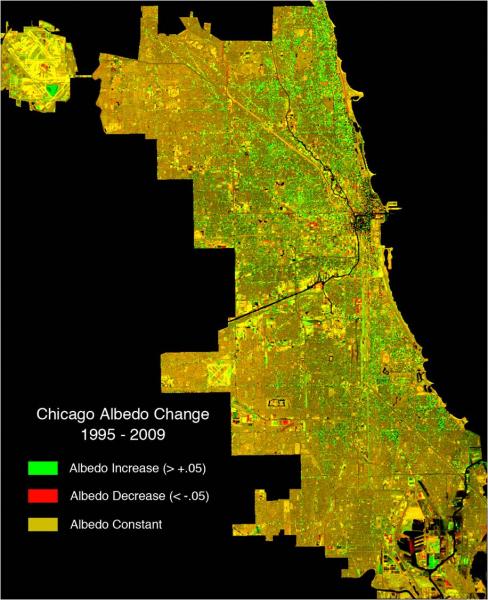Description
Since the great Chicago heat wave of 1995, the city government has enacted a large number of policies under the pretense that it is combating its urban heat island. While much investigation on the subject thus far has focused on either the local benefits of policies or broad descriptions of the entire region, few studies have evaluated whether the small-scale benefits of policies have begun to collectively impact the larger heat island. This study addresses this issue by using LANDSAT imagery to observe changes in Chicago’s vegetated and reflective surfaces in relation to changes in surface temperature since 1995. This is accomplished using two images from early June of 1995 and 2009 with similar air temperature and atmospheric conditions.
Preliminary Results:
- It is difficult to determine whether the total vegetation in Chicago increased or decreased from 1995 to the present since vegetation varies drastically with precipitation (especially in the case of urban grass and lawns). However, both areas that clearly gained vegetation and areas that clearly lost vegetation are visible in fairly similar quantities over the city.
- It is certain that the total albedo of the city increased in the test period and it is estimated that this was by roughly 0.0125 (non-vegetated, non-water surfaces of the city increased by roughly 0.0180).
- The fact that the reflectivity increases in Chicago between 1995 and the present are more noticeable than vegetation changes suggests that reflective policies and efforts may have been more widespread than those of vegetation.
- Within single images of Chicago, NDVI above .3 (proportional to the amount of vegetation) is strongly correlated to lower temperatures (-0.663 ) while albedo is weakly correlated (-0.122).
- However, the positive changes in NDVI above .3 between 1995 and the present are weakly correlated to a temperature decreases (-0.109 ) while positive changes in albedo are fairly strongly correlated (-0.338 ).
- The higher correlation of albedo increase to temperature decrease suggests that the reflective policies and efforts in the test period were more effective at cooling the city than the vegetation efforts.
- While increasing vegetation to abundance may be the ideal method of addressing the issue of urban heat island as suggested by the stronger correlation of NDVI to low temperatures in single images of the city, a reflective strategy might be much more effective at least over a 15-year period.
- Observation of aerial images reveals that most of the reflectivity increases in Chicago that decreased temperatures were the result of new reflective roofs that were likely brought about by new energy efficiency zoning codes. Other cities facing heat island problems might consider implementing similar strategies.
Presentations
- Presentation on June 23rd
- Presentation on July 21st: Replicated Experiment
- Preliminary Results Presentation: Aug 11th
- Final Result_Presentation: Sep 30th
- Atmospheric correction: 2011. Mar 3rd
Useful links
- OEFS Course Project Paper by Chris Mackey
- Rosenzweig et al. 2009. Mitigating New York City’s Heat Island. American Meteorological Society. 1297-1312.
- Ya Ma et al. 2010. Coupling urbanization analyses for studying urban thermal environment and its interplay with biophysical parameters based on TM/ETM+ imagery. International Journal of Applied Earth Observation and Geoinformation. 12: 110-118.
- Taha et al. 1999. Impacts of Large-Scale Surface Modifications on Meteorological Conditions and Energy Use: A 10-Region Modeling Study. Theoretical and Applied Climatology. 62: 175-185.
Albedo Change in Chicago (1995-2009)
